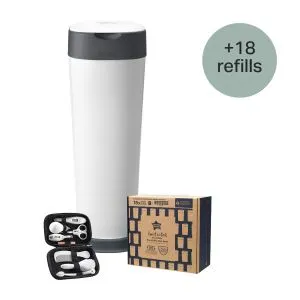
Ultimate XL Nappy Disposal Bundle with 18 Refills
Bundle & Save 40%
Subscription orders can be cancelled at anytime. Free delivery on all subsequent subscription orders. Find out more about subscriptions.
They’re easy and fuss free
Your products are automatically sent to you
You save up to 10% when you sign up for a subscription
You can cancel at any time

As you get closer and closer to the big day, it's a good idea to start thinking about how you want your birth experience to play out, and writing a birth plan can really help!
From info about your birth partner to pain relief options, you'll need to gather your thoughts and note down any preferences you might have, so everyone involved is on the same page.
For first-time parents, this can be a little daunting and can feel a little like a test - but don't worry, we're here to guide you through it and hopefully make the birth plan planning a little easier.
A birth plan, put plainly, is a record of what you want to happen during your labour, delivery and after.
This can include virtually anything you want the healthcare professionals delivering your baby to know, and it will be included within your maternity records.
If you've received advice from your maternity team that you want to stick with during your birth, you'll want to add that to your birth plan. If you have specific preferences about the position you'd prefer for labour, chuck that in.
Remember, different people have their own unique birth plans - this isn't GCSE Maths, you can't copy off your pal. Sure, take advice, but make sure that YOUR personal preferences that fit your circumstances are included in your birth plan. It's all about you and your baby after all.
Your birth plan is a way for you to help the health professionals supporting you. It lets you share information so they can care for you and meet your wishes, but no matter what you say in your birth plan, you can change your mind and consent to different care at any time.
First things first, it's important to include your name, the names of anyone in your medical care team, and your contact information.
Aside from that, there's a lot that you can include in your birth plan to help your delivery team know what you're after during your delivery. Depending on your specifics, like whether you want a home birth, a more holistic birth, or if you're after a water birth or you want to explore hypnobirthing - you'll need to detail your ideal environment and other conditions you require when you go into labour.
It's important to remember to be flexible, though. Your delivery team will try and follow your birth plan as much as they can but ultimately, they'll do what's best for you and the baby in the moment. You're allowed to change your mind whenever you want and so are the healthcare professionals. Remember, everyone has your best interest in mind. Plus, sometimes they don't have a spare pool in the hospital and apparently calling dibs doesn't mean anything.
The first thing you'll want to include in your birth plan is where you intend on giving birth. Depending on what's available in your area, you can give birth:
Your midwife will probably explain your best options and outline the benefits of each, but the decision is yours. You might find it helpful to get some advice from the pros (your mom friends). Most hospitals and maternity units offer tours - go and have a nosey round. And you can always change your mind about where you'd like to give birth - things don't always go to plan in labour and your main concerns might change in the moment, which is totally fine.
If you're having a planned C-section, you should include as much information about this as possible in your birth plan. It's a good idea to think about:
Having a birth partner offers way more benefits than just having someone to yell at while you're pushing. It's been shown to reduce the need for pain relief while in labour - suppose having someone there to hold your hand is its own pain relief of sorts. But you'll need to provide some information about your birth partner in your birth plan.
You need to outline who they are and where you're comfortable with them being while you're in labour. For example, would you want your birth partner with you if you need a C-section? Or if you require a forceps or vacuum delivery? All this needs to be outlined in your birth plan.
During labour, delivery and the postpartum period, some people decide to have a doula present to advocate for them and provide emotional support.
A doula is a trained professional who offers non-medical support throughout the birthing process. They can help with pain management techniques, provide reassurance, and act as a liaison between the birthing person and medical staff.
When selecting a doula, it's important to have an initial consultation to discuss expectations and preferences. You can also decide how involved they will be in the lead-up to the birth and in the birthing room. Remember to communicate any specific needs or preferences, such as those regarding religion or language, with your doula to ensure a positive and supportive birthing experience.
If you've decided that you'd like to have the support of a doula, be sure to note this down in your birth plan.
Think about what position(s) you'd prefer to be in during labour and birth. This can depend on how active you'd like to be up until the birth - will you be standing and walking around when they're almost here, or are you more of a relaxer? Here are some popular ones that might appeal to you:
Plus loads more! You can lie on your side, lie down in bed, or kneel against some pillows - whatever you think will be most comfortable for you.
This is probably the one that requires the most research. You can try breathing and relaxation tactics, massage and maybe being in warm water to relieve some of the pressure. Other than that, it's good to consider any other methods of pain relief you might like to try to assist with delivery.
These can include:
At this stage, it's also worth including if you'd like to try and use hypnobirthing techniques. Helping ease anxiety and stress with hypnobirthing can be an effective and natural form of pain management and one that more and more mums-to-be are opting for.
There are some great tools and gadgets that can help a lot during labour. Sometimes maternity units and hospitals can provide you with the equipment you'd like, but in other circumstances, you'd have to provide your birthing equipment yourself. This is something that your midwife will be able to advise you on.
Let's run through some of the birthing tools that you might consider.
If you have any unique needs or preferences, it's important to make note of these in your birth plan. Examples of these important additional requirements include:
Now that we've covered what you need to think about when writing the delivery-specific part of your birth plan, let's run through any information you should include about what you'd like to happen once your baby's been born.
The placenta is delivered after your baby is born. This is known as the third stage of labour, and there are two options for delivering the placenta - active management and physiological management.
Active management involves an injection of a medication known as oxytocin in your thigh. The purpose of this injection is to stimulate contractions in your uterus, which helps to detach the placenta from the uterine wall. Typically, the placenta is delivered within half an hour of receiving the injection.
Physiological management means that you won't be given any drugs to help you deliver your placenta.
It's a good idea to research these two options and include your preference in your birth plan.
There are a range of things you can do with the placenta after you've given birth and it's important to decide what you'd like to do and include it as part of your birth plan.
In recent years, the practice of "placentophagy", or consuming the placenta has gained popularity, but opinions about this practice remain divided.
Some people claim that eating the placenta:
But despite these claimed benefits, studies have found no data to back them up.
Your placenta is full of valuable stem cells and can be donated. Head to NHS Organ Donation to learn more.
If you're not sure what you'd like to do with your placenta just yet, but you know that you don't want to discard it, that's ok! You can bank it. Head to Cells4Life to learn more.
You can make a balm using your placenta and organic beeswax, coconut oil and essential oils, and apply this to sore or cracked nipples caused by breastfeeding.
Some parents decide to bury their placenta in the garden and plant a tree or shrub on top of it as a way of commemorating their baby's birth. To do this, dig down at least 12 inches and remember to add a layer of soil between the placenta and the roots of the plant.
Some parents like to pop on some gloves and have a feel of their placenta. It's an amazing organ and is worth admiring!
If you're not particularly interested in your placenta and don't want to try any of the above ideas, no stress! You're not obliged to do anything with it, and you can simply let the hospital, birth centre of midwives dispose of it.
It's important to remember that if your birth doesn't happen the way you imagined (for whatever reason) it's not your fault and is often entirely out of your hands.
Birth plans can be useful in helping you to think through your preferences but should always be held lightly.
Equally if your birth plan is to have no plan and just go with the flow, that's absolutely fine, too!